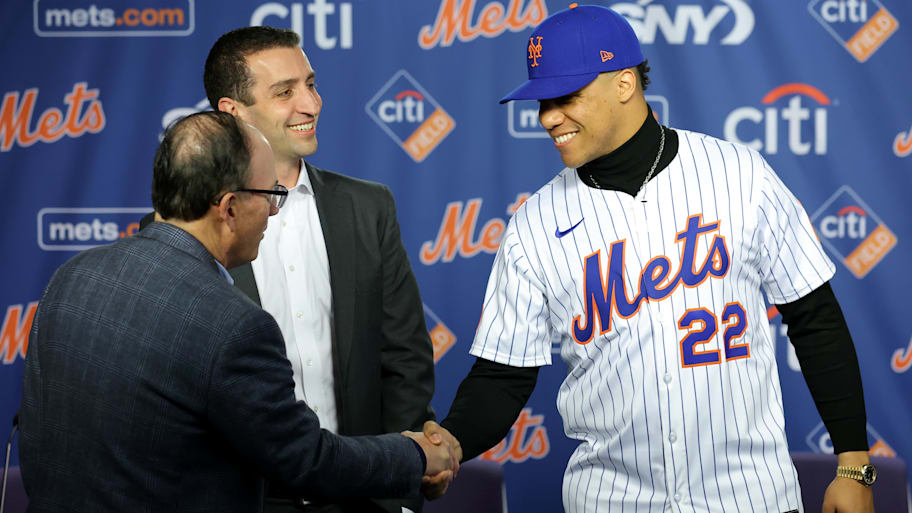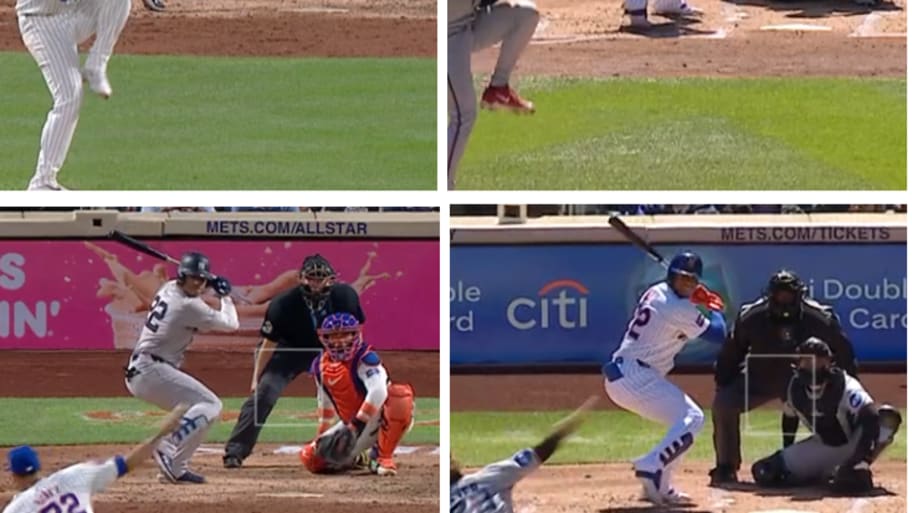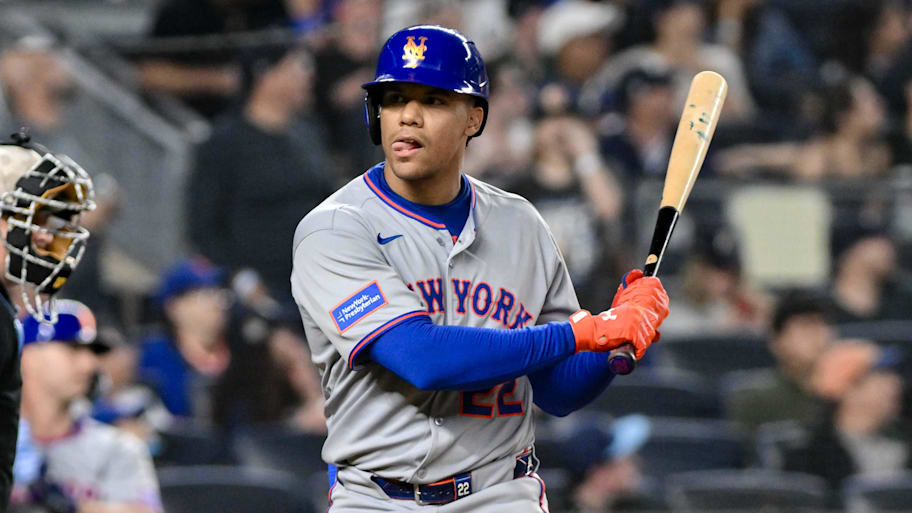What in the world is going on with Juan Soto? The New York Mets outfielder is getting beat by fastballs, he is rightfully getting crushed for not hustling on at least two instances, he has lost bat speed and is in the midst of his first-ever 10-game span with no extra base hits and 12 strikeouts.
It’s a tribute to his ability to draw walks that Soto still posted a .815 OPS and 134 OPS+ in his first 48 games with the Mets. But he is not being paid $756 million over 15 years to scratch out walks. More telling of his state of mind than any of his stats is his body language. Frankly, it is awful, and it is manifesting itself in a lack of explosiveness at the plate.
Theories abound about this lesser version of Soto. When it comes to getting inside his head, leave it to his agent, Scott Boras, who speaks with him regularly, to provide a diagnosis.
“The moniker,” Boras says. Soto is the highest paid player in baseball ever. And though he changed teams twice before, to the Padres and the Yankees, both occasions were via trade. This time, with this title of Highest Paid, is way different. There is more pressure, more expectations, more scrutiny.
“It’s taking time to learn how to wear the crown,” Boras says. “I cautioned Juan about it. This 90-day period of assimilation, I’ve seen it time and time again. There’s probably another 30 days to go through. It’s going to get better and better. It’s about learning how to wear the crown.
“The hardest part that the public doesn’t anticipate is that this is the kind of situation that comes around maybe once every 10 or 15 years or so: a generational talent on a record contract. Juan’s approach with the crown is an adjustment. I told him, ‘You’re going to get your pitches to hit. Swing less. You’re not there yet.’”
Soto’s return to Yankee Stadium was particularly rough for him. Jogging out of the box on a groundball to second base in a close game was the worst of it, unless you count the regrettable language directed at him from the stands. Boras says it was the first time Soto had a chance to speak with his former teammates and that the weekend was “a catharsis” for him. The agent downplayed the idea that Soto regrets his decision to sign with the Mets.
“With free agency, any choice you make comes with regrets,” Boras says. “It’s human nature. It’s the salad that comes with the steak. It’s human nature.”
Soto’s free agency was largely viewed as a Yankees vs. Mets battle, but Boras says Toronto Blue Jays ownership made “a great proposal” that impressed Soto and that “I could have gotten more money from the Boston Red Sox. They were that into it. Juan had many choices.”
Soto chose the Mets because owner Steve Cohen mounted a personal, family-friendly campaign and because Cohen’s personal wealth and ambition provided the most assurance that Soto will always play for a title contender.
The money quote from my SI story with Soto in spring training came from asking him why he chose the Mets: “How many times we can be good on this team. I know the Yankees are going to be good for the next five, six years. We don't know after that.”
The Yankees, Soto said then, started out in his free agency as his first choice. But where Cohen stepped up at every turn, starting from an initial meeting at his house when other teams met Boras’s request to meet at a hotel, Soto said the Yankees were more passive in their pursuit.
“But I don't know … I just feel like … It's just weird,” Soto said. “It's kind of like … How can I explain it?” Then, after a long pause, he continued, “I feel like the Yankees did a pretty good job. But they, they keep, they couldn't get it done right. Like, I wanted to get it done, but they're still bouncing around. Here … at least that … maybe … maybe not … instead of just get it done right away. Yeah, just get it done. Let's get a good, uh, good feeling. You know what I want. You know what I’m trying to get. They're still bouncing around. So, I feel like that was one of the things that kind of like sent me down.”

Until Soto conquers this “wearing of the crown” break-in period, he is not the same hitter. Here are most obvious ways Soto has regressed, with all stats updated entering Wednesday’s games:
1. He is not into his lower half as much as a hitter.
Here is a look at Soto in 2024 on the left and 2025 on the right as the pitcher is at leg lift and at ball release. You clearly see he is more upright and less athletic this year. He does not coil and spring through the baseball as he did last year.

“You’re right,” Mets manager Carlos Mendoza says. “You’re on to something. I like him much better right now with two strikes, because then he spreads out and gets into his legs more.”
When I mention to Boras that Soto’s discomfort is showing with physical manifestations such as his more upright posture in the box, the agent says, “You have to know how to balance the crown to wear it. What is hitting? Hitting is balance.”
2. Soto has not been doing the full-on Soto Shuffle.
We have seen abbreviated versions of it, but not the “In-your-face-I-own-you” body language sent to the pitcher when he takes a pitch. The swagger is not there.
3. Soto can’t drive low pitches.
This is probably a function of his more upright posture. Soto always has been a much better high-ball hitter than low-ball hitter, but he is doing almost no damage on pitches at the bottom of the strike zone and lower:
Compare the lack of production on low pitches this year to the damage he did on the same pitches last year:
4. Soto has trouble with velocity.
Now there is a sentence you thought you would never read. Last year Soto slugged .718 against pitches 95 mph and faster. Only Rafael Devers (.722) was better. This year he ranks 83rd against 95+, with a slug versus elite velocity that is down almost 300 points.
5. Soto has lost bat speed.
Soto is having trouble with velocity because his bat is not as quick. His bat speed on those 95+ pitches has dropped significantly, from 75.6 mph to 72.2 mph. Overall, only two batters have lost more bat speed this year than Soto (Lamonte Wade Jr. of the Giants and Josh Naylor of the Diamondbacks).
The Mets have seen this movie before, only not at the same investment level. On this date in 2021, his first year with the Mets, Francisco Lindor was hitting .185. Soto is a generational player. He made his major league debut seven years ago Tuesday. His career on-base percentage on his seven-year anniversary was .419. According to the Elias Sports Bureau, only four players have ever been better at getting on base through their seventh anniversary: Frank Thomas, Wade Boggs, Todd Helton and Albert Pujols.
But Soto is not the highest paid player in baseball just because he draws walks. The Mets need him to do damage, especially with their offense hitting a historic funk. The Mets entered Wednesday having lost five of six without a home run and only eight runs and 40 total bases. It was their worst offensive week since Casey Stengel’s 109-loss outfit of 1964.
The good news for Soto is that he is healthy, and he has not lost his preternatural understanding of the strike zone. In due time, as with Lindor, Soto will return to mashing. But if Boras is right about what Soto is going through, the Mets may need to endure another month of this low-wattage, bad-body language version of Soto. The crown is still too heavy.
More MLB on Sports Illustrated
This article was originally published on www.si.com as Juan Soto’s Underwhelming Start Is Both a Physical and Mental Issue.
